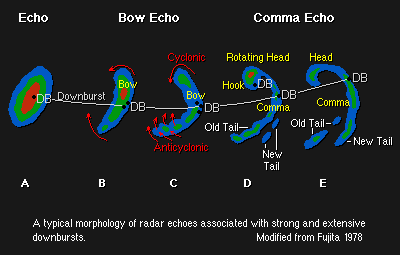
Mesoscale Meteorology
Severe Convection II: Mesoscale Convective Systems
4.1 Overview

One of the more significant and intriguing forms of mesoscale convective organization is the bow echo. Bow echoes are relatively small (20-120 km or 10-65 n mi long), bow-shaped systems of convective cells that are noted for producing long swaths of damaging surface winds.
In 2004 Klimowski and coauthors defined a bow echo as a non-transient bow- or crescent-shaped radar signature with a tight reflectivity gradient on the convex leading edge, the evolution and horizontal structure of which is consistent with storms that propagate along a strong outflow. Note that this definition is not specific in the size, duration, or evolution of the storm, only its shape and association with strong winds.
Fujita was among the first to document bow echo evolution. A bow echo often starts as a strong isolated cell or a small line of cells that evolves into a symmetric bow-shaped segment of cells over a period of a couple hours. In the early phases, cyclonic and anticyclonic line-end vortices, known as bookend vortices in bow echoes, are evident at the northern and southern ends of the bow. Recent research indicates that while most bow echoes live several hours, the bowing stage itself often forms very quickly.